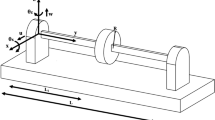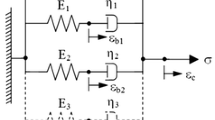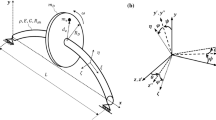Abstract
A reduced-order dynamic model for an unbalanced rotor system is developed, taking the coupling between torsional and lateral vibrations into account. It is assumed that a shaft is regarded as a continuous viscoelastic shaft with unbalanced and small deformation properties. The equations of motion for the torsional and lateral vibrations are derived using Lagrange’s approach with the frequency-dependent shape function. The rotor torsional vibration is coupled with the lateral vibrations by unbalance elements in a way of excitations. Simulation and experiment results show clearly that the torsional vibration has strong impact on the rotor lateral vibrations, and it causes subharmonic and superharmonic excitations through unbalance elements, which leads to the superharmonic resonances in the lateral vibrations. This model with low-order and high accuracy is suitable for rotor dynamic analysis in real time simulation as well as for active vibration control syntheses.
Similar content being viewed by others
References
RUHL R L, BOOKER J F. A finite element modell for distributed parameter turborotor systems, transactions of ASME [J]. Journal of Engineering for Industry, 1972, 94: 126–132.
GUO Rui, JANG Sung-hyun, CHOI Young-hyu. Torsional vibration analysis of lathe spindle system with unbalanced workpiece [J]. Journal of Central South University of Technology, 2011, 18(1): 171–176.
CHEN Rui-lin, ZENG Qing-yuan, ZHANG Jun-yan. New algorithm applied to vibration equations of time-varying system [J]. Journal of Central South University of Technology, 2008, 15(S1): 57–60.
YUAN Zhen-wei, CHU Fu-lei, LIN Yan-li. External and internal coupling effects of rotor’s bending and torsional vibrations under unbalances [J]. Journal of Sound and Vibration, 2007, 299(1/2): 339–347.
HUANG D G. Characteristics of torsional vibrations of a shaft with unbalance [J]. Journal of Sound and Vibration, 2007, 308(3/4/5): 692–698.
PATEL T H, DARPE A K. Experimental investigations on vibration response of misaligned rotors [J]. Mechanical Systems and Signal Processing, 2009, 23(7): 2236–2252.
GUYAN R J. Reduction of Stiffness and Mass Matrices [J]. AIAA Journal, 1965, 3(2): 380.
SHIAU T N, HWANG J L. A new approach to the dynamic characteristic of undamped rotor-bearing systems [J]. ASME Transactions, Journal of Vibration, Acoustics, Stress and Reliability in Design, 1989, 111: 379–385.
ALTHAUS J. An active hydraulic bearing for rotor system [C]// Proceedings Reviews VDI Duesseldorf: VDI-Publish, 1991: 154.
NELSON W J, CHEN H D. Undamped critical speeds of rotor systems using assumed modes [J]. ASME Transactions, Journal of Vibration and Acoustics, 1993, 115: 367–369.
LI W, ENGE H. Investigation on a suitable reduced-order rotor system model for active vibration control [C]// Synergies between Information Processing and Automation, Technische Universitaet Ilmenau, 2004: 55–61.
LI W, MAISSER P, ENGE H. Self-learning control applied to vibration control of a rotating spindle by piezopusher bearings [J]. Proceedings of the I MECH E Part I: Journal of Systems and Control Engineering.2004, 218(3): 185–196.
AL-BEDOOR B. Modeling the coupled torsional and lateral vibrations of unbalanced rotors [J]. Computer Methods in Applied Mechanics and Engineering, 2001, 190(45): 5999–6008.
MAISSER P. Analytical dynamics of multibody system [J]. ZAMM, 1988, 68(10): 463–481.
RITZ W. Theory of transverse vibrations [J]. Annals of Physics, 1909, 333(4): 737–786.
BREMER H. Dynamic and control of mechanical system [M]. Stuttgart: Teubner Study Book, 1988.
ORTEGA R. Passivity-based control of Euler-Lagrange systems: Mechanical, electrical and electromechanical applications [M]. Berlin: Springer, 1998.
BREMER H. Kinetic rigid-elastic multi-body system [C]// Proceedings Reviews VDI, Duesseldorf: VDI-Publish, 1983: 53.
Author information
Authors and Affiliations
Corresponding author
Additional information
Foundation item: Project(51105017) supported by National Natural Science Foundation of China; Project(2011BAG09B00) supported by the National Science and Technology Support Program, China; Project(2010DFB80020) supported by the National Science and Technology Major Project of the Ministry of Science and Technology of China
Rights and permissions
About this article
Cite this article
Wang, Sh., Guo, W., Xu, Xy. et al. Modeling unbalanced rotor system with continuous viscoelastic shaft by frequency-dependent shape function. J. Cent. South Univ. 20, 3421–3430 (2013). https://doi.org/10.1007/s11771-013-1866-3
Received:
Accepted:
Published:
Issue Date:
DOI: https://doi.org/10.1007/s11771-013-1866-3




